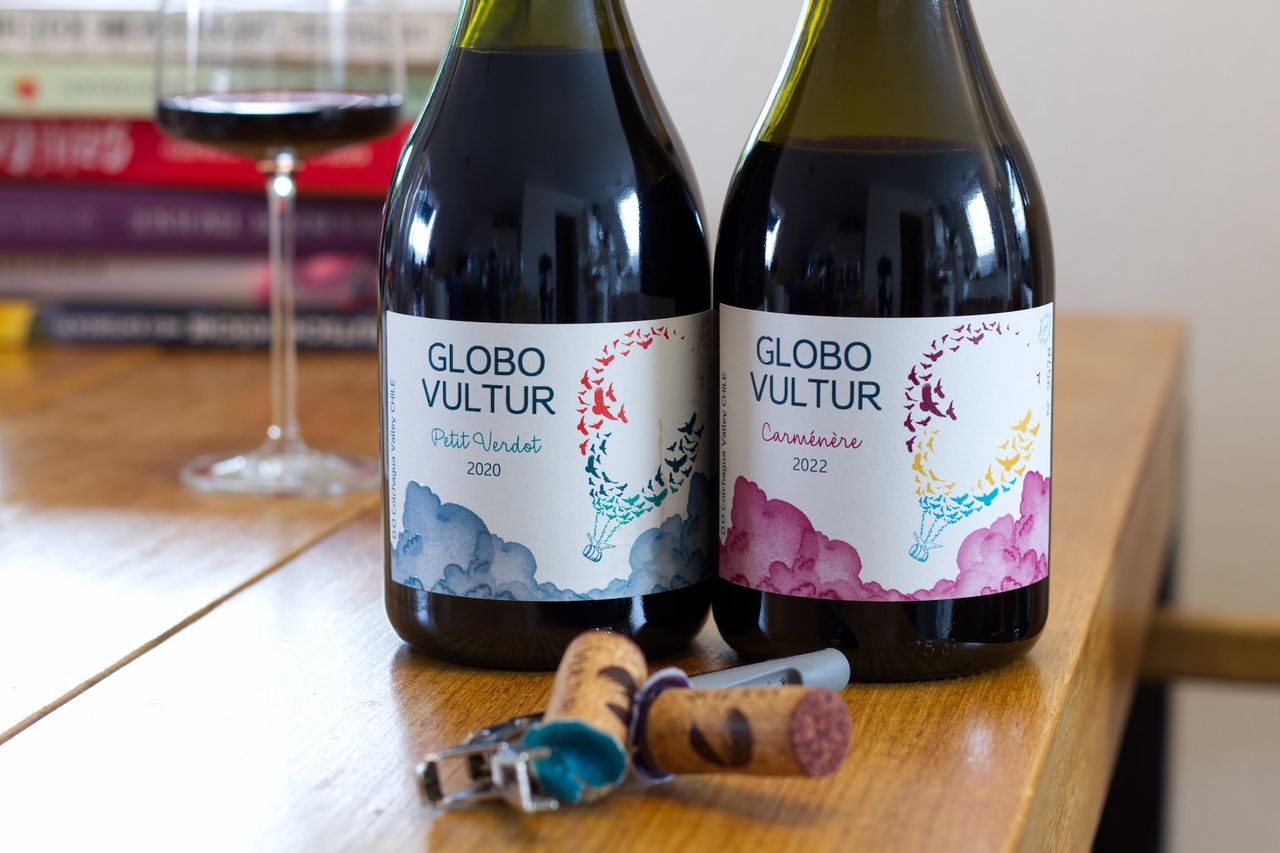Two Bottles Globo Vultur
We are drinking two wines from Chile: from Vultur Wines, from the Globo Vultur series, one bottle of Carménère 2022 and one bottle of Petit Verdot 2020.

The original idea for our Rheinhessen recap, to end with these two bottles directly after the wines from Achenbach, was thwarted by the parcel service, gravity, and the earth’s hard surface. If you look closely at the picture, you can still spot stained remains from the Carménère on the right side of the Petit Verdot. Considering a bottle of red wine broke, the other labels actually looked remarkably fresh. I guess cardboard just absorbs well. Luckily, Mom likes sweet Huxelrebe, so another bottle of Carménère could go undercover on its way to Württemberg. Sending single bottle replacements around is a bit of a waste and this way, it was a full box and everyone’s happy. Mom because of the Huxelrebe, and me because I can still finish my recap as planned, albeit with a slight delay. Of course, we didn’t hop across the big pond after the Maxime Open to taste wines there too, the connection to Rheinhessen is another. Conni Achenbach is Chilean, and so the Achenbachs import a few wines from there to expand their own range. We drink wine from Chile very rarely, so these two bottles were more than appropriate additions with our first order. That the labels are so stylish is an extra bonus.
Wine has been cultivated in Chile since the mid-19th century, when French winemakers immigrated and brought along varieties that are still grown today. That’s why we’re drinking Carménère and Petit Verdot today, grapes you mainly find in Bordeaux in Europe. Interestingly, Chile escaped phylloxera and later served as an export nation for graft-free vines. Besides, the climate means there’s less pressure from fungal diseases, so less plant protection is needed. Vines are grown on just over 200,000 hectares, about twice the area under vine in Germany. Today’s two wines come from the Colchagua Valley region, right in the middle of the country, a bit south of Santiago de Chile. Daniel and Alejandra produce their wines here under the name Vultur Wines. Both wines, the Carménère and the Petit Verdot,to which about 10% Carignan is added, mature for 14-18 months in French oak before being bottled unfiltered.
The Petit Verdot is really aromatic with loads of fruit, dark, nearly black berries, a bit of violet, blackberry, fine spice and licorice. On the palate the wine is leaner than I expected. The tannin is firm but not coarse, gripping but not annoying, and as you swish the wine around your tongue, the nose becomes earthier. The few years in bottle are noticeable, everything is getting silkier and softer, both in the scent and in the taste. I think it was much more unruly when first bottled. If I wanted to complain, I’d say it lacks a bit of tension, but I don’t want to complain, and across the table I immediately hear “I don’t think so” anyway.
A night doesn’t change the wine. The second evening, though, is quite warm, meaning the attic, not the wine, and I can’t shake the feeling that I’d like the Petit Verdot much better with about 15 degrees less ambient temperature. It’s not exactly a summer wine. There’s now a lot of strawberry in it, about three quarters of the way to jam. Just the strawberry, not the wine itself. As I said, I quite like that, but I’d prefer it even more in winter.
The amount of varietal Carménère I’ve had before can be counted on one finger. If at all. In any case, my brain screams Cabernet Franc as soon as I stick my nose in the glass. After a quick look at Wikipedia, this actually makes sense because Cabernet Franc is one of the parent varieties. I was briefly rather proud of my nose. The wine is much spicier than the other. There’s bell pepper and that slightly rustic tannin that I so love from the Loire. Some smoke, earth, leather and cherry mixed with red and black currants. It comes across cool, focused, and spicy and tastes just like it smells. Blackberry leaf, herbal and rustic. I really like that, and with air, sage comes through, along with a hint of Swiss herbal candy. What would follow in German now would be a pun on the advertising slogan of said Swiss herbal candy. After all, there are mountains in Chile, too. But I don’t know if they use the same slogan everywhere, so we just leave it at that.
The Carménère gets even more herbal the next evening. When drinking, the aftertaste on the tongue now reminds me of Amaro, just without the high alcohol. The bell pepper remains, the red fruit too. The wine has become softer, its rustic side has faded. I’m probably a terribly bad blind taster, but the green bell pepper in the Cabernet orbit is pretty unmistakable. It’s less clear why I love that in red wine but can’t stand it in Sauvignon Blanc. In any case, the Carménère is brilliant, and I’d definitely prefer it on the first night rather than the second, so I wouldn’t want to forget it in the cellar for too long. Not because I think it won’t age well, but the risk that time will soften it too much is too great for me. I simply enjoy that scruffy resistance too much when drinking.